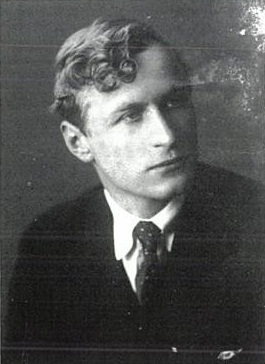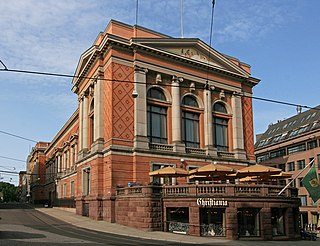
Nasjonal Samling was a Norwegian far-right political party active from 1933 to 1945. It was the only legal party of Norway from 1942 to 1945. It was founded by former minister of defence Vidkun Quisling and a group of supporters such as Johan Bernhard Hjort – who led the party's paramilitary wing (Hirden) for a short time before leaving the party in 1937 after various internal conflicts. The party celebrated its founding on 17 May, Norway's national holiday, but was founded on 13 May 1933. Nasjonal Samling was made illegal and disbanded at the end of World War II, on 8 May 1945.

Vidkun Abraham Lauritz Jonssøn Quisling was a Norwegian military officer, politician and Nazi collaborator who nominally headed the government of Norway during the country's occupation by Nazi Germany during World War II.

The Centre Party, formerly the Farmer's Party, is an agrarian political party in Norway.

Anders Sigurd Lange was a Norwegian political organiser, speaker and editor who led his eponymously named political party Anders Lange's Party into parliament in 1973.

Jens Valentinsen Hundseid was a Norwegian politician from the Agrarian Party. He was a member of the Norwegian parliament from 1924 to 1940 and the 20th prime minister of Norway from 1932 to 1933.
The Free-minded Liberal Party was a political party in Norway founded in 1909 by the conservative-liberal faction of the Liberal Party. The party cooperated closely with the Conservative Party and participated in several short-lived governments, including two headed by Free-minded Prime Ministers. In the 1930s the party changed its name to the Free-minded People's Party and initiated cooperation with nationalist groups. The party contested its last election in 1936, and was not reorganised in 1945.
Øystein Sørensen is a Norwegian historian. A professor at the University of Oslo since 1996, he has published several books on the history of ideas, including Norwegian nationalism and national socialism, as well as general Norwegian World War II history.
Sverre Mitsem (1907–2004) was a Norwegian journalist, newspaper editor and article writer. He is known as editor-in-chief of Tønsbergs Blad from 1954 to 1977 and for the column "SORRY" in Aftenposten, which he wrote from 1946 to 1996.

The Quisling regime, or Quisling government are common names used to refer to the fascist collaboration government led by Vidkun Quisling in German-occupied Norway during the Second World War. The official name of the regime from 1 February 1942 until its dissolution in May 1945 was Den nasjonale regjering. Actual executive power was retained by the Reichskommissariat Norwegen, headed by Josef Terboven.

Victor Andreas Emanuel Mogens was a Norwegian journalist, editor and politician for the Fatherland League.

Alf Larsen Whist was a Norwegian businessperson and politician for Nasjonal Samling.
Odd Erling Melsom was a Norwegian military officer and newspaper editor.

Ansgar Eugène Olaussen was a Norwegian newspaper editor, educated as a typographer, and politician. As a politician he started in Young Communist League of Norway (Norges Socialdemokratiske Ungdomsforbund, and notably edited Klassekampen from 1911 to 1921. For the Labour Party he was county leader, central board member and MP for slightly more than a year, until he joined the Communist Party in 1923. Some years after finishing his sole term as an MP for the Communists, he shifted to the far right and associated himself with Nazism during the Second World War.
Arbeideren was a daily newspaper published in Oslo, Norway.
Ørnulf Egge was a Norwegian politician for the Workers' Youth League and Communist Party and resistance member during World War II.

The Conservative Press Association was a Norwegian media institution whose stated objective was the furtherance of conservative daily newspapers. Amongst its members were editors, journalists, publishers and businesspeople who were involved in declared conservative newspapers. The activity in the association faded out concurrently with the discontinuance of party newspapers in Norway.

Øyvor Hansson, née Styren was a Norwegian politician for Nasjonal Samling.
The National Socialist Workers' Party of Norway was a minor extraparliamentary political party in Norway. The party was founded in 1930, and dissolved in May 1940.



















